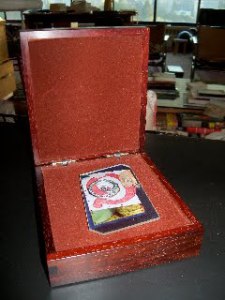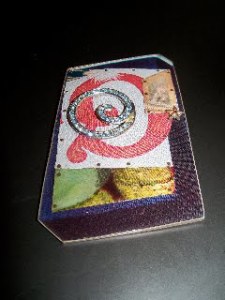Brazen Beauty/Less Fragility
A Few Notes on Tony Berlant at LA Louver
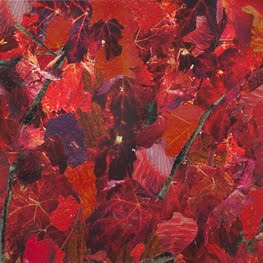
Waylaid, 2010. Courtesy of the LA Louver Gallery
Despite the fact that most of my working life centers on a MacBook, I have never mastered the nuances of Photoshop or Excel. Contemporary art that appears dependent on recent technology gives me pause, and usually doubt. This was the main challenge with Tony Berlant’s recent show at the LA Louver Gallery in Venice, California (through August 28).
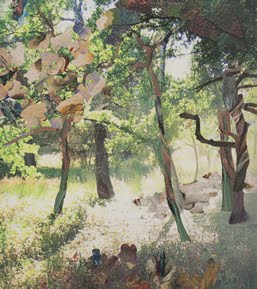
Upward, 2010. Courtesy of the LA Louver Gallery
Part of the appeal of Berlant’s work has always been the way it reveals the evidence of its making: he cuts up pieces of tin printed with imagery and hammers them to wooden panels using thousands of brads. Although the pieces of metal are unmoving, the collages remind me of paper briefly anchored in place by tiny dots. I relate to the suggestion of a constant questioning: maybe this piece of paper would be better over here?
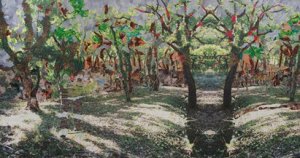
Terrace, 2010. Courtesy of the LA Louver Gallery
His method is not burdened by scale. He satisfies my craving for the miniature (I really want one of his little house-shaped forms from the 1980s) and for the epic scene that can be looked at hundreds of times and still reveal new combinations (check out “Dancing on the Brink of the World” in the South Terminal at SFO next time you are there).
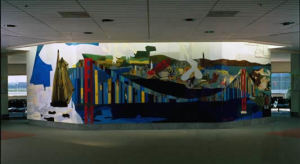
Dancing on the Brink of the World, 1987. Commission for San Francisco Airport
But this new exhibition goes in new directions.
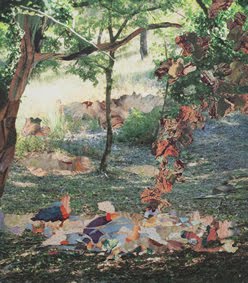
Highlight, 2010. Courtesy of the LA Louver Gallery
Berlant has used photographs previously in his work, but here they dominate. He adheres manipulated landscape photographs—taken at an estate near Aix-en-Provence—directly onto wood panels. He has experimented with this kind of technology before to develop the basis for covering most if not all of his surfaces in tin collage. In these new works, the modified image dominates the picture plane. I couldn’t get out of my mind the idea that they would fade over time. But so does paint. Of course, lots of modern works need constant attention, like Rauschenberg’s combines.
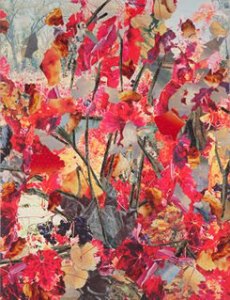
Break Away, 2010. Courtesy of the LA Louver Gallery
In his earlier works, Berlant took tiny scraps of the familiar and reworked them, jigsaw-puzzle style, into a cohesive reality Collage often works in archetypes. Like therapy! Berlant is old-fashioned in that his images celebrate beauty. Here he does it with bravado, a sureness in the power of the image and its brazen color placed over the trademark snippets of metal.
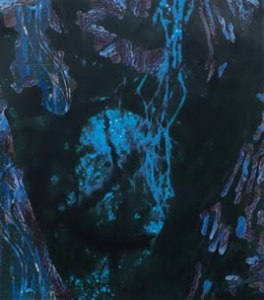
Long Shot, 2010. Courtesy of the LA Louver Gallery
The current show feels tethered to the photograph and thus to a clearer version of reality. Only some of the puzzle is finished, and digitally altered photos tell the rest of the visual story. It’s easy to feel shortchanged when you really want the artist to keep puzzling and cover the entire surface with those tiny bits of a jigsaw, countless brads marking his labor. But the more you look, you see tree trunks made out of flowers and shadows full of garden scraps. The piece entitled “Chateau” offers some sinister shadows. The four deep blue pieces were the most unusual; they conjured up a wicked nighttime scene few of us have seen. In these pieces, Berlant veers away from reworking found bits of reality into sheer beauty and moves towards creating a more ambiguous landscape that tests reality from a different vantage point. It is a stepping-off point, but it is hard to know where it will go next.
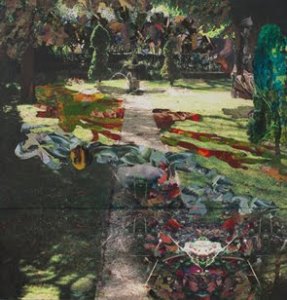
Chateau, 2010. Courtesy of the LA Louver Gallery
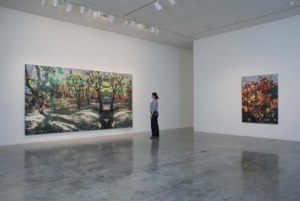
Installation Photography, 2010. Courtesy of the LA Louver Gallery
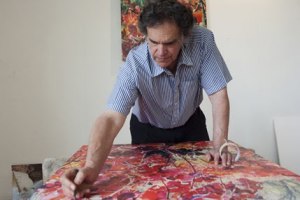
Studio process photography, Tony Berlant, 2010. Courtesy of the LA Louver Gallery
Coda
9/1/10
A few days after posting this blog a brooch by Tony Berlant came up on Ebay. Thanks to Paul’s skillful bidding I won! It arrived today and here are a couple of photos. My first Tony Berlant piece.
